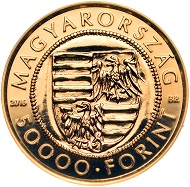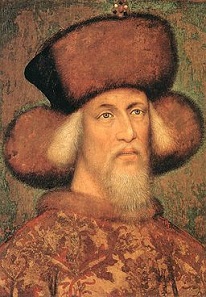November 10, 2016 – With the issue of King Sigismund’s gold florin, the Magyar Nemzeti Bank continues its series “Medieval Hungarian Gold Florins”, launched in 2012 with the gold Florins of Charles I (2012), Louis I (2013) and Mary, Queen of Hungary (2014).
Hungary / 50,000 HUF/ .986 Au / 3.491 g / 20mm / Designer: Soltra E. Tamas.
The Coin
The front of the coin depicts the coat-of-arms of Sigismund’s first type of gold florin, as designed by sculptor Tamas E. Soltra. The back depicts Saint Ladislaus holding a battle-axe in his right hand and the orb in his left hand, with the letters M-O by his sides, the mark of Buda Chamberlain Mikes Jemnisti, and the number 13 between the legs of the saint. This piedfort version has the legend “SIGISMVNDI . D . G . R VNGARIE” (of Sigismund, by the Grace of God King of Hungary). In addition to the piedfort version, a 2,000-florin base metal version is also being issued with the same design.
Sigismund of Luxembourg. Artist: Pisanello (c. 1395 – c. 1455). Source: Wikipedia.
Sigismund of Luxembourg
Sigismund of Luxembourg was born in Prague on 24 February 1368, the son of Holy Roman Emperor Charles IV and Elizabeth of Pomerania. As the husband of Mary, Queen of Hungary, the daughter of Louis I, Sigismund was crowned King of Hungary on 31 March 1387 in Szekesfehervar. One of the most important rulers of the late Middle Ages, he pursued especially vigorous domestic and foreign policies: he travelled extensively, organised crusades and his name is also linked to the end of the first major schism in the Western church. He was crowned King of Bohemia in 1420 and Holy Roman Emperor in 1433. Although he had two wives (Mary of Anjou and Barbara of Cilli), he had no male heir, and thus Albert Habsburg, the husband of his daughter Elizabeth, was named as his successor. He died on 9 December 1437 in Znojmo (Moravia) and was buried in Nagyvarad (present-day Oradea).
The Florin of Sigismund
During the reign of Sigismund, the coat-of-arms on the front of the Hungarian gold florin was changed. Under the reign of Louis I, the typical design of the gold florin with the combined arms of the country and the ruling house (Hungary-Anjou) on the front and Saint Ladislaus on the back had appeared. Sigismund’s only change to this design was to replace the party per pale arms with a quartered coat-of-arms. Sigismund essentially minted two types of gold florin. After accession to the throne, the first coins featured the Hungarian stripes and the eagle of Brandenburg on the front. Having been named regent of Bohemia in 1402, the eagle was replaced with the Bohemian lion. An extremely rare version of the latter coin exists, with Arabic numerals (5, 6, 7 and 13) found between the legs of Saint Ladislaus on the back. Researchers have not been able to provide a reliable answer to the meaning of these numbers, but they were probably series marks used to distinguish the various issues. The typically Hungarian system of mint marks and master marks was also developed under Sigismund. The marks to the two sides of Saint Ladislaus on the back of the coin, which may represent letters or coats-of-arms, referred to the mint location on the one hand and the chamberlain responsible for minting on the other.
This CoinsWeekly article reported on the first gold florin in the series, depicting Charles I, in 2012.
Here you can read the article about the second gold florin in the series, depicting Queen Mary, in 2014.
You can find more information on the website of the Hungarian Mint.







